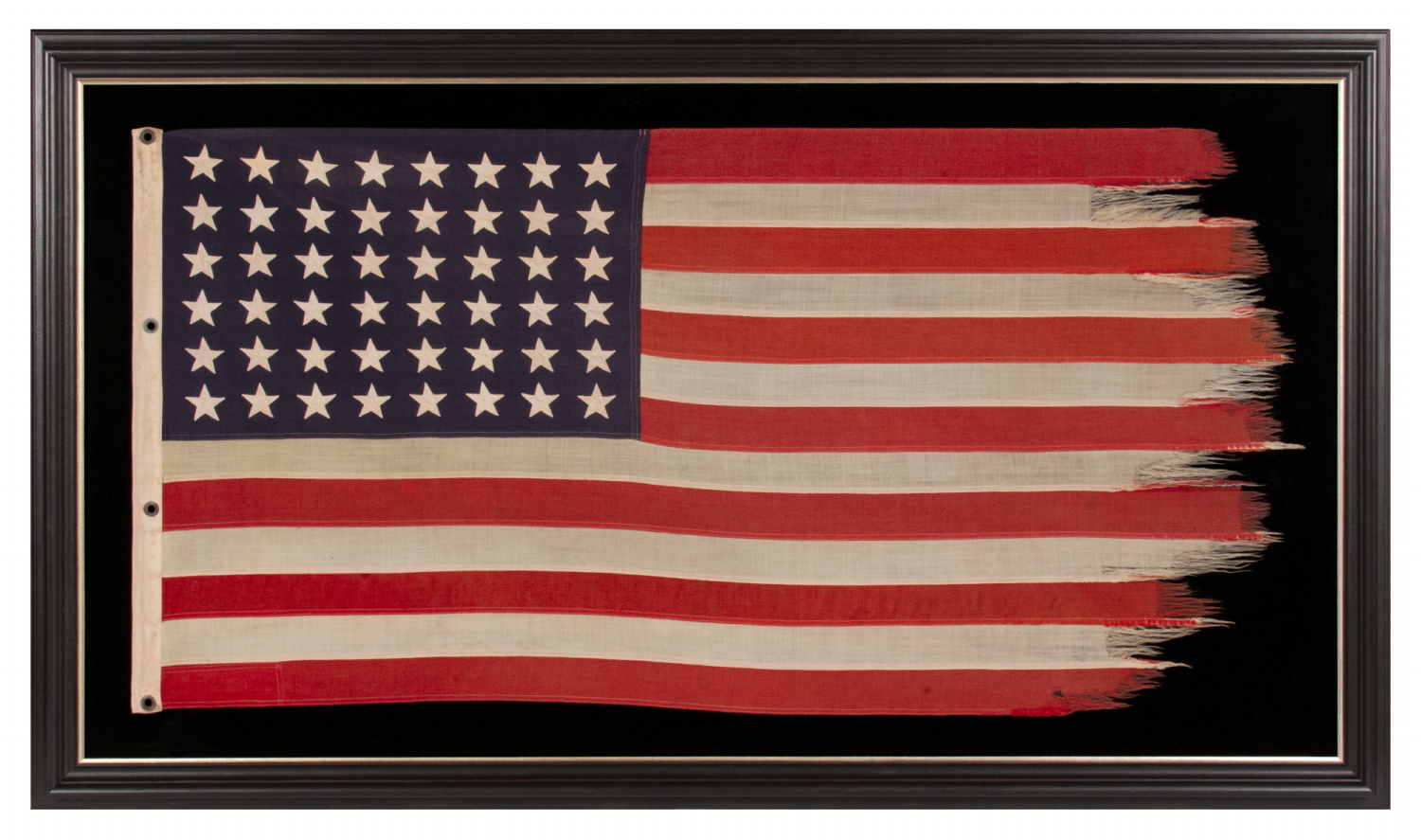
| |
ANTIQUE AMERICAN FLAG WITH 48 STARS, A U.S. NAVY SMALL BOAT ENSIGN, MADE IN JUNE OF 1943, DURING WWII, AT MARE ISLAND, CALIFORNIA, HEADQUARTERS OF THE PACIFIC FLEET, WITH ENDEARING WEAR FROM OBVIOUS LONG-TERM USE |
|
| Available: |
Sold |
| Frame Size (H x L): |
44.5" x 76.5" |
| Flag Size (H x L): |
32.25" x 66" |
|
| Description....: |
|
48 star, U.S. Navy small boat ensign, made during WWII (U.S. involvement 1941-45) at Mare Island, California, Headquarters of the Pacific Fleet. A black stencil along the hoist, on the reverse, reads as follows: "U.S. Ensign No. 11; Mare Island June 1943.” While U.S. involvement in the Second World War (1941-45) necessitated the acquisition of flags from many sources, the Navy had long made their own flags at several locations, of which this was one. "NO. 11" is a size designation for a small boat flag that, per U.S. Navy Regulations of 1914, was to measure 2.9 x 5.51 feet.
The canton and stripes of the flag are made of wool bunting, of an unusually heavy weight, that has been pieced and sewn with machine stitching. The elongated patches in the upper and lower, hoist-end corners are called gussets. These are original to the flag's construction and were added for reinforcement at the points where it was subject to the most wear. The stars are made of cotton and are double-appliquéd (applied to both sides) with a zigzag machine stitch. There is a heavy canvas binding along the hoist, with four metal grommets. The general manner in which the flag is made, with higher grade fabrics and uncommonly stout construction, is indicative of U.S. Navy flags of the WWI-WWII era.
Although the specific history of this flag has been lost to time, the fact that it displays proper evidence of having been flown for an extended period is unusual among surviving examples. Most flags of this nature, brought home by sailors, were ships stores. Endearing wear from legitimate use, especially during wartime, is far more unusual. It can also contribute significantly to a flag’s visual and historical attraction, which is certainly the case here.
The 48 star flag became official in 1912 following the addition of New Mexico and Arizona. It remained the official flag throughout WWI (U.S. involvement 1917-18), WWII (U.S. involvement 1941-45), and the Korean War (1950-53), until Alaska gained statehood in 1959 and the 49th star was added.
Located on the western edge of the City of Vallejo, about 23 miles northeast of San Francisco, Mare Island (actually a peninsula) served as a principal seat of U.S. Navy defense, beginning in the mid-19th century. The site was originally chosen following an expedition that set forth in 1850, when Commodore John Drake Sloat was ordered to lead a survey party in quest of a logical site for the nation's first Pacific naval installation. Sloat recommended the island across the Napa River from the settlement of Vallejo; it being "free from ocean gales and from floods and freshets." On November 6th of that year, two months after California was admitted to statehood, President Fillmore reserved Mare Island for government use. The U.S. Navy Department acted favorably on Commodore Sloat's recommendations and Mare Island was purchased in July, 1852, for the sum of $83,410 for the use as a naval shipyard. Two years later, on September 16th of 1854, Mare Island became the first permanent U.S. naval installation on the West Coast, with Commodore David G. Farragut serving as Mare Island's first base commander.
The base became home to what was known as the Pacific Fleet, and remained so until the threat of Japanese expansionism caused the shift to a more advanced position at Pearl Harbor. It was very active in WWII, Korea, and Vietnam, but would eventually close in 1993, after Congress approved the findings of the Base Realignment and Closure Report.
Mounting: The flag was mounted and framed within our own conservation department, which is led by expert staff. We take great care in the mounting and preservation of flags and have framed thousands of examples.
The black-painted, hand-gilded, and distressed molding is Italian. The background is 100% cotton twill, black in color, that was washed and treated for colorfastness. The glazing is U.V. protective acrylic (Plexiglas).
Condition: There is minor to moderate soiling along the hoist, and minor to moderate of the same in the stars. The grommets display significant corrosion and rust. There is significant loss from wind shear and fraying along the fly end. There are extremely minor holes elsewhere, in limited areas. Many of my clients prefer early flags to show their age and history of use. |
|
|
|
| Collector Level: |
Intermediate-Level Collectors and Special Gifts |
|
| Flag Type: |
Sewn flag |
|
| Star Count: |
48 |
|
| Earliest Date of Origin: |
1943 |
|
| Latest Date of Origin: |
1943 |
|
| State/Affiliation: |
California |
|
| War Association: |
WW 2 |
|
| Price: |
SOLD |
|
| |
Views: 976 |
|
|
|

